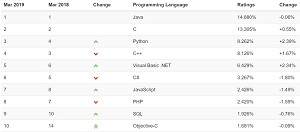News
Did Microsoft's .NET Core Initiative Boost PowerShell Usage?
Microsoft's move from the ageing Windows-only .NET Framework to the open source, cross-platform .NET Core framework may come with ancillary consequences, such as a boost in the popularity of its PowerShell scripting language.
At least, that's the speculation of TIOBE, which produces a monthly index gauging the popularity of programming languages.
TIOBE found little of note in its new March report, so it dug down into the data to find something newsworthy: PowerShell has reappeared in the top 50.
"There are hardly any interesting changes in the TIOBE index this month," the report said. "We had to use our magnifying glass to spot some news, i.e. that PowerShell entered the TIOBE index top 50."
It actually came in at No. 45, between Hack and Awk, on the strength of a 0.180 percent increase in the popularity gauge from last year.
"The PowerShell scripting language is more than 12 years old and it has been in the top 50 before," the report said. "PowerShell is typically used for basic scripting. Until recently it was only available for Windows but Microsoft used its .NET Core platform to create PowerShell Core. This version is open source and runs on all major platforms. This might be the reason why PowerShell is getting more popular again."
 [Click on image for larger view.] March 2019 TIOBE Top 10 (source: TIOBE).
[Click on image for larger view.] March 2019 TIOBE Top 10 (source: TIOBE).
Otherwise, it was pretty much business as usual, with the top 10 languages in March 2019 being mostly the same as March 2018, with a few changing positions. One of those that changed positions among the top 10 was Visual Basic.NET, which continued its rise that was a main topic of the February report.
VB.NET rose from No. 6 in last year's March report to No. 5 this year, exchanging places with another Microsoft language, C#.
One notable move occurred with Groovy, which vaulted to No. 16 this year from its No. 60 position last year. That was the biggest move in the top 20 by far. Just plain Visual Basic ("classic," before VB.NET took over in 2002), fell from No. 15 last year to No. 20 this year.
TIOBE bases its index on the number of worldwide skilled engineers, courses and third-party vendors, using popular search engines such as Google, Bing, Yahoo!, Wikipedia, Amazon, YouTube and Baidu. "It is important to note that the TIOBE index is not about the best programming language or the language in which most lines of code have been written," the firm says.
About the Author
David Ramel is an editor and writer at Converge 360.